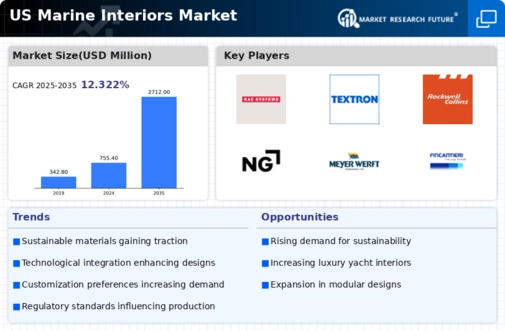Rising Demand for Luxury Yachts
The marine interiors market experiences a notable surge in demand for luxury yachts, driven by affluent consumers seeking bespoke experiences on the water. This trend is reflected in the increasing sales of high-end vessels, with the luxury yacht segment projected to grow at a CAGR of 5.5% through 2027. As consumers prioritize comfort and aesthetics, manufacturers are compelled to innovate in interior design, utilizing premium materials and advanced technologies. The marine interiors market is thus adapting to these preferences, focusing on creating opulent environments that enhance the overall yachting experience. This shift not only boosts sales but also encourages investment in high-quality craftsmanship and sustainable materials, aligning with the evolving expectations of luxury consumers.
Increased Focus on Safety Regulations
The marine interiors market is significantly influenced by the heightened focus on safety regulations within the boating industry. Regulatory bodies are implementing stricter guidelines regarding materials and design standards to ensure passenger safety and environmental compliance. This shift necessitates that manufacturers invest in research and development to create interiors that meet these evolving standards. For instance, the use of fire-resistant materials and non-toxic finishes is becoming a requirement, thereby impacting the design choices available in the marine interiors market. As compliance becomes paramount, companies that proactively adapt to these regulations are likely to gain a competitive advantage, positioning themselves as leaders in safety and innovation.
Growth of Eco-Friendly Marine Solutions
The marine interiors market is increasingly driven by the growth of eco-friendly marine solutions, as consumers become more environmentally conscious. This trend is reflected in the rising demand for sustainable materials and energy-efficient designs. Manufacturers are responding by incorporating recycled materials and developing interiors that minimize environmental impact. The market for eco-friendly marine products is projected to expand, with a CAGR of 6% anticipated over the next five years. This shift not only aligns with consumer preferences but also encourages innovation within the marine interiors market, as companies strive to create sustainable yet luxurious environments that appeal to eco-conscious consumers.
Technological Advancements in Marine Design
Technological advancements play a pivotal role in shaping the marine interiors market, as innovations in materials and design processes enhance the functionality and aesthetics of marine vessels. The integration of lightweight composites and eco-friendly materials has become increasingly prevalent, allowing for more efficient designs that do not compromise on luxury. Furthermore, the use of 3D printing technology is revolutionizing the production of custom components, enabling manufacturers to meet specific client demands with greater precision. As a result, the marine interiors market is witnessing a transformation that not only improves the quality of interiors but also reduces production times and costs, fostering a competitive edge in the market.
Expansion of Recreational Boating Activities
The marine interiors market is benefiting from the expansion of recreational boating activities across the United States. As more individuals and families engage in boating for leisure, the demand for well-designed interiors that enhance the overall experience is on the rise. This trend is supported by a growing interest in outdoor activities and a desire for unique experiences on the water. The marine interiors market is thus witnessing an increase in investments aimed at improving interior designs, catering to the needs of recreational boaters. This expansion not only boosts sales but also encourages innovation in design, as manufacturers seek to create versatile and comfortable spaces that accommodate various recreational activities.


















Leave a Comment